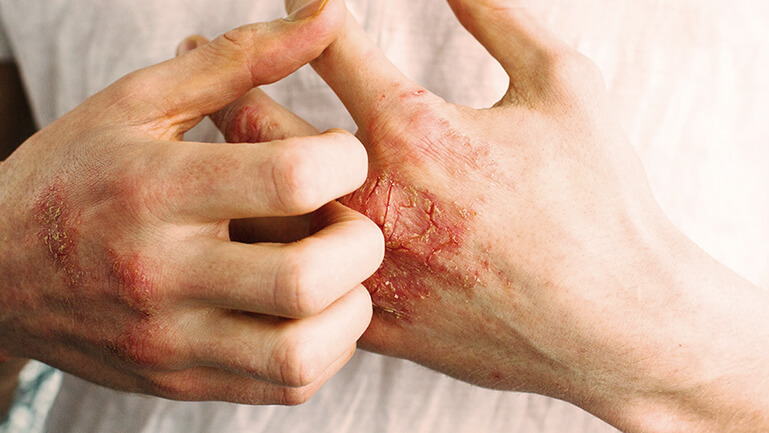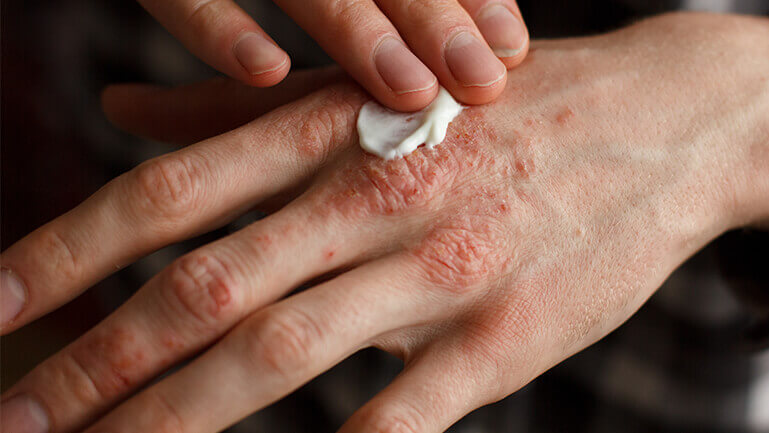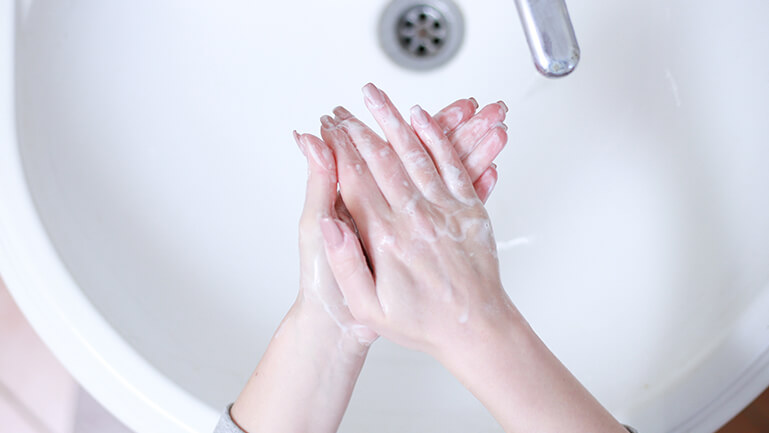Stärke deine Haut
mit Sanubiom SkinCare Protect mit Phage Technology
- REDUZIERT Rötungen und Juckreiz
- FÖRDERT das Gleichgewicht der Haut
- STÄRKT die Hautschutzbarriere
Neurodermatitis

Whether at work, in nature or at home, our hands are our most important tools and are therefore exposed to high levels of stress. For this reason, they are particularly vulnerable and therefore require special care. Sensitive hands, cracks, itching and blisters as well as dry, flaky and thickened skin are signs of neurodermatitis on the hands.
Neurodermatitis on the hands or hand eczema is a disorder of the skin barrier on the hands. This skin barrier is disturbed by external stimuli or predisposition and becomes unbalanced. Cracks appear.
Constant contact with irritants such as hand soaps, but also water itself, can disrupt this balance on the hands and weaken the skin’s natural protective mechanism. If this protective shield is not intact, bacteria, allergenic substances and fungi can spread.
If the disease is not treated, it can take months or even years to fight it. Relapses with recurring attacks are also not uncommon and should be treated as quickly and consistently as possible.

Every skin type requires different care and atopic dermatitis on the hands often occurs with dry and flaky skin. There are also small cracks and redness, but blisters accompanied by itching are also possible. If the hands are affected by atopic dermatitis, it is not uncommon for the feet to suffer from the same symptoms.
mit Sanubiom SkinCare Protect mit Phage Technology
Probiotic
Skin protection
Neurodermatitis on the hands is divided into three subtypes. A mixed form of several subforms usually occurs, but an isolated form can also occur.
Allergic hand eczema
Allergic hand eczema is caused by contact with allergenic substances. Itching on the skin is typical, but small blisters can also appear on the palms and sides of the fingers. These symptoms occur shortly after contact with the substances. These substances include cosmetics, fragrances, paints, plastics, household products and adhesives.
Irritant-toxic hand eczema
This hand eczema occurs very frequently and is triggered by irritating substances. On the one hand, it is caused by soaps, disinfectants and certain foods. On the other hand, frequent hand washing, wearing gloves at work or working in a damp environment can also cause eczema. It often starts on the fingertips and the back of the hand and spreads from there.
Atopic hand eczema
This form occurs when there is already a predisposition and there is a connection to neurodermatitis. The immune system and allergic reactions play a major role here, as a genetically weakened skin barrier is more susceptible to external influences. Atopic hand eczema often occurs in conjunction with hay fever or asthma. Skin eczema is also found in the areas typical of neurodermatitis.

The causes of hand eczema are numerous and vary depending on the subtype. It is very important to find out exactly which irritating substances a patient comes into contact with in order to combat the causes. Often the reason for eczema is the profession, as some occupational groups are constantly in contact with moisture and chemicals. These vulnerable professions include medical staff, masseurs and hairdressers. But stress can also lead to a worsening of the disease.
The easiest way is to prevent contact with allergies and substances that cause hand eczema. If you have not had any skin problems up to this point, it is important to protect your hands at work, for example.
If you have already had to deal with skin eczema in the past, it is important to apply long-term therapy and educate those affected about the right care for good skin protection.
The most important thing is to reduce direct skin contact with the triggering substances to a minimum if possible. Wearing gloves and protecting the skin barrier is particularly important here.
If itching is severe, the skin flora is often out of balance. This is caused by an excess of inflammation-promoting bacteria on the skin, mostly Staphylococcus aureus .
The so-called phage technology relies on the use of phages. These phages are also called bacteriophages and are specialized in recognizing and dissolving bad bacteria on the skin. 1
This gives the good bacteria space again, the skin can calm down and feelings of tension, redness and itching are reduced.
Author: Christian Unterlechner, Dipl.-Ing. (FH), MBA
“From our own experience with neurodermatitis – and the long path of suffering associated with skin conditions like this – we started to look for alternative solutions to drug treatments. We are very happy to share the knowledge and experience that has gone into the years of developing our SkinCare products with you.”
Share post